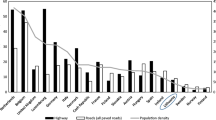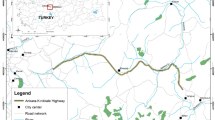Abstract
Wildlife-vehicle collisions (WVC) are important in wildlife management due to their increasing socioeconomic impacts and pervasive effect on some endangered species. In this study, we depict the involved species and evaluate the geographic distribution and economic cost of this human-animal interaction in Spain. We used unpublished information on 74,600 WVC reported by police statements from 2006 to 2012. These collisions accounted for 8.9 % of all reported road traffic accidents in the country. They were unevenly distributed, with WVC accounting for 30–50 % of all road traffic accidents in some mountainous provinces in the north. Results show that wild boar (Sus scrofa) and roe deer (Capreolus capreolus), two abundant free-ranging ungulates (O. Artiodactyla) whose populations have expanded throughout Spain during the last few decades, were involved in 79 % of WVC. These species were responsible for most economic losses and, in the case of the wild boar, for most human injuries. The number of vehicle collisions involving large carnivores (O. Carnivora) was small, with the red fox (Vulpes vulpes) present in most cases (70 %). They included some endangered species (brown bear, Ursus arctos, and Iberian lynx Lynx pardinus). The results provide a reliable picture of WVC in Spain and provide the first assessment of the economic cost of this wildlife-human interaction (105 million € yearly).

Similar content being viewed by others
References
Abellán JM, Martínez JE, Méndez I, Pinto JL, Sánchez FI (2010) El valor monetario de una vida estadística en España, Estimación en el contexto de los accidentes de tráfico, Universidad de Murcia y Universidad Pablo de Olavide, funded by Dirección General de Tráfico, 111 pp
Acevedo P, Farfán MA, Márquez AL, Delibes-Mateos M, Real R, Vargas JM (2011) Past, present and future of wild ungulates in relation to changes in land use. Landsc Ecol 26:19–31
Benayas JR, Martins A, Nicolau JM, Schulz JJ (2007) Abandonment of agricultural land: an overview of drivers and consequences. CAB Rev Perspect Agric Vet Sci Nutri Nat Res 2(57):1–14
Barrientos R, Bolonio L (2009) The presence of rabbits adjacent to roads increases polecat road mortality. Biodivers Conserv 18:405–418
Caletrio J, Fernández JM, López J, Roviralta F (1996) Spanish National inventory on road mortality of vertebrates. Global Biodivers 5:15–18
Calzada J, Guzmán JN, Rodríguez A (2007) Lynx pardinus (Temminck, 1827). Ficha Libro Rojo. Pp. 345–347. In L.J. Palomo, J. Gisbert, y J.C. Blanco (eds.). Atlas y Libro Rojo de los Mamíferos Terrestres de España. Dirección General para la Biodiversidad-SECEM-SECEMU, Madrid. 588 pp
Camps F, Rosell C, Boronat C, Fernández-Bou M, Martínez M, Navàs F, Serra V (2012) Estudi de l’accidentalitat provocada per animals en llibertat a la xarxa de carreteres de la Generalitat de Catalunya, Generalitat de Catalunya, Departament de Territori i Sostenibilitat, Direcció General de Carreteres, Unpublished report. 212 pp
Carbone C, Gittleman JL (2002) A common rule for the scaling of carnivore density. Science 295:2273–2276
Carretero MA, Rosell C (2000) Incidencia del atropello de anfibios, reptiles y otros vertebrados en un tramo de carretera de nueva construcción. Boletín de la Asociación Herpetológica Española 11:39–43
Clevenger AP, Chruszcz B, Gunson KE (2001) Highway mitigation fencing reduces wildlife-vehicle collisions. Wildl Soc Bull 29:646–653
Coffin AW (2007) From roadkill to road ecology: a review of the ecological effects of roads. J Transp Geogr 15:396–406
Colino VJ, Lizana M (2012) Herpetofauna and roads: a review. Basic Appl Herpetol 26:5–31
Colino VJ, Lizana M, Peris SJ (2011) Factors influencing wolf Canis lupus roadkills in Northwest Spain. Eur J Wildl Res 57(3):399–409
Conover MR, Pitt WC, Kessler KK, DuBow TJ, Sanborn WA (1995) Review of human injuries, illnesses, and economic losses caused by wildlife in the United States. Wildl Soc Bull 23:407–414
Danzberger JB (2009) La caza: un elemento esencial en el desarrollo rural. El nuevo sistema agroalimentario en una crisis global”. Mediterráneo Económico 15:183–203
Delibes M, Rodriguez A, Ferreras P (2000). Action plan for the conservation of the Iberian Lynx (Lynx pardinus) in Europe. Nature and Environment, 111.Council of Europe
Delibes-Mateos M, Farfán MA, Olivero J, Márquez AL, Vargas JM (2009) Long-term changes in games species over a long period of transformation in the Iberian Mediterranean landscape. Environ Manag 46:1256–1268
DGT (Dirección General de Tráfico) (2012) Las principales cifras de la Siniestralidad Vial España 2011. Comisión Seguridad Vial y Movilidad Sostenible, Dirección General de Tráfico, Ministerio del Interior, Gobierno de España, Madrid, 32 pp
DGT (Dirección General de Tráfico) (2013) Las principales cifras de la siniestralidad Vial España 2012. Dirección General de Tráfico, Ministerio del Interior, Gobierno de España, Madrid, 151 pp
Farell MC, Tappe PA (2007) County-level factors contributing to deer–vehicle collisions in Arkansas. J Wildl Manag 71(8):2727–2731
Ferreras P, Aldama JJ, Beltran JF, Delibes M (1992) Rates and causes of mortality in fragmented population of Iberian lynx Felis pardina Temminck, 1824. Biol Conserv 61:197–202
Forman RTT, Alexander LE (1998) Roads and their major ecological effects. Annu Rev Ecol Syst 29:207–231
Fundación Oso Pardo (2014). www.fundacionosopardo.org. Accesed 30 April 2014
García-Delgado JDD, Arévalo JR, Fernández-Palacios JM (2007) Road edge effects on the abundance of the lizard Gallotia galloti (Sauria: Lacertidae) in two Canary Islands forests. Biodivers Conserv 16:2949–2963
García-González C, Campo D, Pola IG, García-Vázquez E (2012) Rural road networks as barriers to gene flow for amphibians: species-dependent mitigation by traffic calming. Landsc Urban Plan 104:171–180
Garrido JL (2012) La caza. Sector Económico. Valoración por subsectores. FEDENCA-EEC, Madrid, 24 pp
Groot-Bruinderink GW, Hazebroek E (1996) Ungulate traffic collisions in Europe. Conserv Biol 10:1059–1067
Gunson KE, Mountrakis G, Quackenbush LJ (2010) Spatial wildlife–vehicle collision models: a review of current work and its application to transportation mitigation projects. J Environ Manag 92:1074–1082. doi:10.1016/j.jenvman.2010.11.027
Hodgson JA, Moilanen A, Wintle BA, Thomas CD (2011) Habitat area, quality and connectivity: striking the balance for efficient conservation. J Appl Ecol 48(1):148–152
INE 2014. Evolución de la población en España. Instituto Nacional de Estadística. www.ine.es. Accesed 2 may 2014
IUCN, Unión Internacional para la Conservación de la naturaleza y los Recursos Naturales (2013) The IUCN Red List of Threatened Species 2013,2. www.iucnredlist.org. Accesed 7 January 2014
Iuell B, Bekker H, Cuperus R, Dufek J, Fry G, Hicks C, Hlavác V, Keller V, Rosell C, Sangwine T, Tørsløv N, Wandall B. le Maire (2003) COST 341: Habitat fragmentation due to transportation infrastructure: wildlife and traffic; a European handbook for identifying conflicts and designing solutions. KNNV Publishers
Joyce TL, Mahoney SP (2001) Spatial and temporal distributions of moose–vehicle collisions in Newfoundland. Wildl Soc Bull 29(1):281–291
Junta de Andalucía (2014). www.juntadeandalucia.es/medioambiente. Accesed 30 April,
Kindlmann P, Burel F (2008) Connectivity measures: a review. Landsc Ecol 23(8):879–890
Lagos L, Picos J, Valero E (2012) Temporal pattern of wild ungulate-related traffic accidents in northwest Spain. Eur J Wildl Res 58:661–668
Langbein J, Putman RJ, Pokorny B (2011) Traffic collisions involving deer and other ungulates in Europe and available measures for mitigation. In Putman R, Apollonio M, Andersen R (eds.). Ungulate Management in Europe, Problems and Practices. Cambrigde University Press. Chapter 8. pp 215-259
Langley RL, Mathison J (2008) Worldwide characteristics and mitigation strategies for motor vehicle-animal collisions. In: Bartley GP (ed) Traffic accidents: causes and outcomes. Nova Science Publishers. Inc, New York, pp 75–96
Malo JE, Suárez F, Díez A (2004) Can we mitigate animal-vehicle accidents using predictive models? J Appl Ecol 41:701–710. doi:10.1111/j.0021-8901.2004.00929.x
Mateos-Quesada P (2005) Corzo-Capreolus capreolus. In: Carrascal LM, Salvador A (eds.). Enciclopedia Virtual de los Vertebrados Españoles. Museo Nacional de Ciencias Naturales. Madrid. www.vertebradosibericos.org/. Accesed 12 May 2014
Ministerio de Fomento (2013) Mapa de Tráfico 2012. Principales resultados provinciales y nacionales de tráfico registrado en la Red de Carreteras del Estado (R.C.E.). Secretaría General de Infraestructuras. Dirección General de Carreteras
Morell K, Lehaire F, Lejeune P (2013) Spatio-temporal patterns of wildlife-vehicle collisions in a region with a high-density road network. Nature Conserv 5:53–73. doi:10.3897/natureconservation.5.4634
Mulero A (2013) El paisaje forestal-cinegético en Sierra Morena: una lectura geográfica. Cuadernos Geográficos 52(1):108–128
Mysterud A (2004) Temporal variation in the number of car-killed red deer Cervus elaphus in Norway. Wildl Biol 10(3):203–211
Palomo LJ, Gisbert J, Blanco JC (eds) (2007) Atlas y libro rojo de los Mamíferos Terrestres de España. Dirección General para la Biodiversidad-SECEM-SECEMU, Madrid, 588 pp
Pérez T, Naves J, Vázquez JF, Seijas J, Corao A, Albornoz J, Dominguez A (2010) Evidence for improved connectivity between Cantabrian Brown bear subpopulations. Ursus 21(1):104–108
Rosell C, Fernández-Bou M, Camps F, Boronat C, Navàs F, Martínez M, Sorolla A (2013) Animal-vehicle collisions: a new cooperative strategy is needed to reduce the conflicto. Proceedings ICOET 2013 International Conference on Ecology and Transportation. Scottsdale, Arizona, USA, 23-27th June 2013
Sáez-Royuela C, Tellería JL (1986) The increased population of the wild boar (Sus scrofa L.) in Europe. Mammal Rev 16:97–101. doi:10.1111/j.1365-2907.1986.tb00027.x
Santos X, Llorente GA, Montori A, Carretero MA, Franch M, Garriga N, Richter-Boix A (2007) Evaluating factor affecting amphibian mortality on roads: the case of the Common Toad Bufo bufo, near a breeding place. Anim Biodivers Conserv 30(1):97–104
Seber GA (1982) The estimation of animal abundance and related parameters. Griffin, London, 672 pp
StatSoft (2004) STATISTICA. data analysis software system.version 7. StatSoft, Tulsa
Steiner W, Leisch F, Hackländer K (2014) A review on the temporal pattern of deer–vehicle accidents: impact of seasonal, diurnal and lunar effects in cervids. Accident Anal Prevent 66:168–181
Vanlaar WGM, Gunson KE, Brown SW, Robertson RD (2012) Wildlife-vehicle collisions in Canada: a review of the literature and a compendium of existing data sources. Traffic Injury Research Foundation & Eco-Kare International, Otawa, 69 pp
World Bank (2014) “Densidad vial”. Tablas de Indicadores del desarrollo mundial (WDI). www.datos.bancomundial.org. Accesed 2 May 2014
WWF España (2013) Informe atropellos lince carreteras España 2013, www.wwf.es. Accesed 19 August 2013
Zuberogoitia I, del Real J, Torres JJ, Rodriguez L, Alonso M, Zabala J (2014) Ungulate vehicle collisions in a peri-urban environment: consequences of transportation infrastructures planned assuming the absence of ungulates. PLoS ONE 9(9):e107713. doi:10.1371/journal.pone.0107713
Acknowledgments
Data reported in this paper were kindly provided by Endika Urtaran (Ministry of Industry, Energy and Tourism, Spanish Government), Justiniano Redondo (Jefatura Provincial de Tráfico de Álava, Ministry of Interior, Spanish Government), Carlos Hernáez (Ministry of Development, Spanish Government), Garbiñe Sáez (Director of Traffic, Department of Safety, Basque Government), Victorino García (Road Statistical Department, Basque Government), and Jonatan Calafi (Department of Land and Sustainability, Catalonian Government). We also thank the Guardia Civil, Ertzaintza, and Mossos d’Esquadra officers involved in the collection of data reported in this paper. Sarah Young kindly improved the English of an early draft. AS thanks Charo Zárate for continuous support throughout this investigation. We are indebted to Carme Rosell, who substantially improved an earlier version of this paper.
Conflict of interest
The authors declare that they have no conflict of interest.
Author information
Authors and Affiliations
Corresponding author
Additional information
Communicated by C. Gortázar
Electronic supplementary material
Below is the link to the electronic supplementary material.
ESM 1
(PDF 327 kb)
Rights and permissions
About this article
Cite this article
Sáenz-de-Santa-María, A., Tellería, J.L. Wildlife-vehicle collisions in Spain. Eur J Wildl Res 61, 399–406 (2015). https://doi.org/10.1007/s10344-015-0907-7
Received:
Revised:
Accepted:
Published:
Issue Date:
DOI: https://doi.org/10.1007/s10344-015-0907-7




